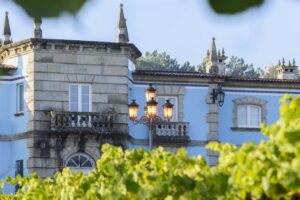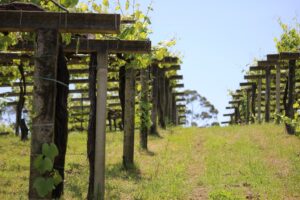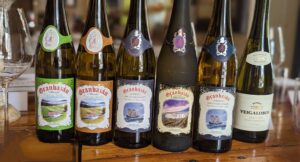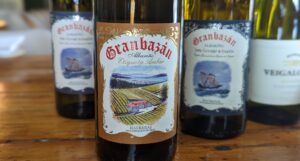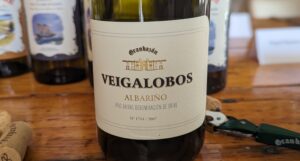The aromas of white flowers and intense minerality immediately enchanted him on his first sip. Then, the fierce, electrifying acidity sent a shiver down his spine like a lightning bolt that made him feel more alive than he had ever felt. It was why he kept coming back to a foreign land that made it virtually impossible to gain citizenship and it is why he passed on other opportunities that would better guarantee a more successful career. But logic goes out the window when every sense in a human is experiencing ecstasy that brings him to another dimension. For some, it is falling in love, others it is an escape to a fantasy world, yet for Diego Ríos, it was German Riesling wine.
German Riesling is not a wine that is broadly appreciated on a fine wine level. Yet, those who discover this intriguing white wine and delve into the best producers are typically entirely smitten by the wines and, on rare occasions, become obsessed to the exclusion of others. Diego Ríos is one of those who became obsessed.
Originally from Chile, Diego decided to take an unorthodox path after studying enology at university by doing an internship at a German winery instead of joining other classmates in California or Australia. But he was fascinated by high-quality German Riesling, a wine that makes one’s mouth water with its high acidity, delights one’s nose with complex aromas and easily ages gracefully for 50 years and beyond. He ended up leaving after his first year in Germany to gain more experience in the US by working at a top winery in Oregon and then returning to Chile to work for a top winery there. However, the siren song of German Riesling had him return to work for a well-known producer in the Mosel wine region in Germany for several years. Despite work visas at the time being extremely difficult to guarantee, he couldn’t imagine giving his sweat, blood and tears to make any other wine… that is, until he met his future destiny at a wine trade convention.
His Passion Yet With A Spanish Soul
In 2015, at the German wine trade convention called Prowein, Diego represented his German winery as he had a good handle on the German language. One of the customers who came to his table to try his wines had an interpreter to translate the customer’s native language into German so he could ask questions. Diego noticed that his native language was Spanish, so halfway through speaking in German, Diego said, “My native language is Spanish too,” hence, they continued in Spanish. The man was Pedro Martínez, and he and his family wanted to buy a couple of top wineries in Europe, the first being in the legendary Spanish wine region Rioja. But the family also loved great white wines and was already in love with German Riesling, which is why he went to this wine trade convention. But unfortunately, the Martinez family couldn’t buy a top estate in Germany.
But Pedro Martinez kept in contact with Diego, as they were still hoping to find a grand white wine estate. The Martinez family was also passionate about the white wines in the Spanish wine region Rías Baixas, near the Atlantic Ocean, nestled in the northwestern area of Galicia. At first, they didn’t even investigate the possibility of buying a well-respected wine estate as the Rías Baixas wines had become quite popular and the newer generation had no desire to sell. By chance, the admired Bodegas Granbazán property was placed for sale due to the owner’s failing health. Pedro jumped at the opportunity to buy an esteemed name that came with a significant amount of vineyards, which was unheard of as many of the Rías Baixas wine producers have no vineyards as most of the land is owned by several families that each have a stake in a tiny plot of vines.
When Diego heard that Pedro could buy Bodegas Granbazán, he was beside himself as the vineyards were in a prime location in the Salnés Valley known for its high acidity, mineral-based, saline-driven white wines. Diego could not become the winemaker of Bodegas Granbazán until 2019 due to the long process of getting a work permit. Still, the minute he found out that he had finally found a wine home where he could start doing in-depth research to reach the nirvana of white wine, all he thought about was the property of Granbazán and how he could elevate it to its full potential.
Bodegas Granbazán
Bodegas Granbazán was founded in 1981 by a local family that had made their money in the canned fish industry. They were part of the quality revolution of Rías Baixas wines as, during that time, stricter regulations were put in place to make higher quality wines and today, even though it is a small wine region, it has taken the US by storm as another alternative to Sauvignon Blanc and Riesling for those looking for refreshing, aromatic white wines. The native white grape variety is called Albariño and despite being once considered a relative of Riesling brought by French monks, when the DNA of the grape was analyzed, it was determined to be a native variety unrelated to Riesling. But its qualities are similar to Riesling, so it is no wonder why those looking for excellent aromatic, high-acidity wines have gravitated to it.
Not only was Bodegas Granbazán known for focusing on quality in the vineyards but they made a lineup of Albariño white wines that showcased different aspects of the vineyard as well as other qualities in the wine that were enhanced by various winemaking methods, such as being one of the first to age Albariño in French oak – actually the name of the wine is ‘Limousin’ which is the name of the French forest where the oak is sourced.
Within four years, Diego has already made some improvements with the winery focusing on terroir, aka sense of place, which started with his first Granbazán harvest in 2019; that was an enormous feat to accomplish. Not only do they have around 50 acres of their own vineyards but for their “classic” wine called ‘Etiqueta Verde,’ they need to source from 80 other family growers with their tiny plots of vines, as it is the largest quantity wine they make. Diego changed things up in 2019 by ensuring all the grapes for each plot were harvested on the same day. This way, Diego could ferment each plot in its own tank so he could properly blend different plots with each other, instead of having various plots fermenting in the same tank, so he could make the ideal “classic” blend that represents their sub-region Salnés. The Salnés Valley is known for its mouthwatering acidity and saline minerality, as Diego says the wines have “insane salinity” and if someone wants to know what salinity tastes like in a wine, these are the wines to try. However, it was not easy to convince the growers as it is the families themselves who harvest the grapes and, initially, they didn’t understand why they had to work so much harder harvesting all the grapes in one day when they had been doing fine spreading it over a few days. Yet when they saw the result and understood that their particular plot is given the respect it deserves by devoting a tank just to it, they realized that it is the next level in finding the best expression of their Salnés Valley.
When Diego first arrived in Rías Baixas, he initially felt he had a “thousand eyes on him” as the locals aggressively protected their traditions. They didn’t want this young winemaker with his international background to start making trendy wines instead of respecting what they had already established as the standard for a Rías Baixas wine. But Diego loves the traditional wines of Rías Baixas as that drew him to the place and he only wanted to improve on what was already established. And so, yes, he started to find the nuances in expressing the sense of place as well as steer away from using new French oak in the wines that use it, and instead, use larger barrels of used oak that allow for more of the complexity of Albariño to develop instead of adding flavor.
Tasting The Greatest
Heavenly, transcendent bouquet with tantalizing flavors on the palate with an exquisitely defined body and never-ending mineral-laced finish – simply “mind-blowing;” the last great wine Diego has had and, for a moment, it was easy to think it was one of those old German Riesling wines from an iconic producer that is auctioned for several thousands of dollars. But no, it was a 1989 Bodegas Granbazán ‘Limousin’ Albariño. He is unsure if it is the greatest wine he has ever had but it is near the top of his list. And one day, he is determined to make a Bodegas Granbazán wine, which, after a few decades in the cellar, will be the greatest of the greats he has tasted.
***Link to original Forbes article: https://www.forbes.com/sites/cathrinetodd/2023/11/30/white-wine-producer-who-helped-raise-international-reputation-for-entire-wine-region
Bodegas Granbazán was certified as a Fair’N Green winery last year; it was founded by some of the most respected German wineries, and Bodegas Granbazán is the first winery in Rías Baixas, as well as the first in Spain with its sister winery in Rioja, Bodegas Baigorri, to be certified.
2022 Bodegas Granbazán ‘Etiqueta Verde’ Val do Salnés, Rías Baixas, Spain: 100% Albariño. The 2022 vintage was the hottest year on record for Europe as a whole, even more than the legendary 2003, but Diego said that although it was problematic, they were still able to harvest grapes with lots of acidity and minerality that were only touched with richer fruit flavors. Granbazán’s “classic” expression of the Salnés Valley uses some of their estate fruit and other plots throughout the sub-region among 80 families, which is dominated by granite soil. Notes of salted lemon with sea shell and lemon meringue on the palate with lots of energy and bright acidity.
2022 Bodegas Granbazán ‘Etiqueta Ambar’ Val do Salnés, Rías Baixas, Spain: 100% Albariño. The ‘Ambar’ is the next level up and is the most known in the US. It is considered the “classic Grande Salnés” as it is bigger and has more generous fruit that the previous wine. Half of the fruit is sourced from the Granbazán estate and the other half is the best lots of the 80 families, where only four or five are chosen. Broken rocks with fresh acidity with zingy lemon peel notes and a broader body with juicy peach flavors and spicy notes.
2020 Bodegas Granbazán ‘D. Álvaro de Bazán’ Val do Salnés, Rías Baixas, Spain: 100% Albariño. 2020 was a cool vintage with very high acidity, so these wines will have a long life. All of the grapes are sourced from the Granbazán estate vineyards named Finca Tremoedo. The grapes come from plots with fine sandy granite soil that is highly porous, so the soil in that area is very poor and the vines struggle; tiny grapes with concentrated fruit are produced from these plots. Intriguing notes of orange blossom and pressed flowers with lemon sorbet flavors on the palate with marked acidity and a broad, flavorful finish with saline minerality.
2020 Bodegas Granbazán ‘Limousin’ Val do Salnés, Rías Baixas, Spain: 100% Albariño. ‘Limousin’ is sourced either from the sides of the hill or the top of the hill from the Granbazán estate vineyards. Since the wine is aged in oak from the French forest of Limousin, Diego prefers to pick the grapes with the highest amount of acidity as it does better in oak aging and 2020 was perfect as the acidity was extremely high. Diego is also transitioning the aging of this wine from new, smaller barrels to bigger, seasoned oak. Delectable aromas of quince paste and honeysuckle with a hint of cumin seeds with mouthwatering acidity with a mixture of tropical and citrus fruits on the palate with a very long, expressive finish.
2018 Bodegas Granbazán, D. Álvaro de Bazán, Val do Salnés, Rías Baixas, Spain: 100% Albariño. This is an older vintage with a couple more years on it to showcase the added complexity that occurs with only a couple more years in bottle. Multifaceted nose with dried chamomile, ripe golden apples and honeycomb aromas that has an intense minerality with layers of wet stone and sea spray that has a broad body with nectarine crumb tart on the palate and refreshing acidity on the long, flavorful finish.
2019 Bodegas Granbazán, Veigalobos Vineyard, Val do Salnés, Rías Baixas, Spain: 100% Albariño; waxed top with a modern label as opposed to the traditional labels for Bodegas Granbazán as this is a new project started in 2018. From a walled single vineyard called Veigalobos with granite rock layers of calcareous alluvial elements in its soil, it produces a powerful expression of Albariño. It has some skin contact during fermentation, where 20% of the berries still have their skins intact but they are placed in a sort of tea bag material so they can be removed at any stage of the fermentation to avoid having the skin contact going too far. 2019 was a cooler vintage, which is better for skin contact as grapes that are not too ripe are less likely to produce a wine that is too over the top. Honeycomb with crushed rocks and dried wildflowers with lots of salinity and sour lemon drops with a structured palate that makes this a very gastronomic wine.


